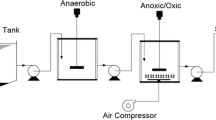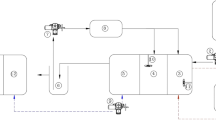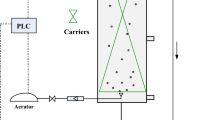Abstract
Sequencing biofilm batch reactor (SBBR) under micro-aerobic condition was applied to the treatment of aniline-contaminated wastewater in this study. Hydraulic retention time (HRT) of 12—36 h and dissolved oxygen (DO) concentration of 0.1—0.5 mg/L were selected as the operating variables to model, analyze and optimize the process. Five dependent parameters, aniline (AN), chemical oxygen demand (COD), ammonium, total nitrogen (TN) and total phosphorus (TP) removal efficiencies as the process responses, were studied. From the results, increase in DO concentration could promote the AN, COD and ammonium removal; increase in HRT could also lead to increase of the AN and ammonium removal, but might decrease COD removal due to endogenous respiration and soluble microbial products. In the SBBR system, 24 h for HRT and 0.5 mg/L for DO concentration were chosen as the optimum operating condition. The actual removal efficiencies of COD, AN and ammonium under the optimum operating condition were 98.37%, 100% and 89.29%, respectively. The experimental findings were in close agreement with the model prediction. The presence of glucose could promote bacterial growth and has positive influence on AN degradation and ammonium removal.
Similar content being viewed by others
References
O’Neill F J, Bromley-Challenor K C A, Greenwood R J, et al. Bacterial growth on aniline: Implications for the biotreatment of industrial wastewater [J]. Water Research, 2000, 34(18): 4397–4409.
Kahng H Y, Kukor J J, Oh K H. Characterization of strain HY99, a novel microorganism capable of aerobic and anaerobic degradation of aniline [J]. FEMS Microbiology Letters, 2000, 190(2): 215–221.
Zhang T, Zhang J, Liu S, et al. A novel and complete gene cluster involved in the degradation of aniline by Delftia sp. AN3 [J]. Journal of Environmental Sciences, 2008, 20(6): 717–724.
Aoki K, Nakanishi Y, Murakami S, et al. Microbial metabolism of aniline through a meta-cleavage pathway: Isolation of strains and production of catechol 2, 3-dioxygenase [J]. Agricultural and Biological Chemistry, 1990, 54(1): 205–206.
Zeyer J, Wasserfallen A, Timmis K N. Microbial mineralization of ring substituted anilines through an ortho-cleavage pathway [J]. Applied and Environmental Microbiology, 1985, 50(2): 447–453.
Schnell S, Schink B. Anaerobic aniline degradation via reductive deamination of 4-Aminobenzoyl-CoA in Desulfobacterium anilini [J]. Archives of Microbiology, 1991, 155(2): 183–190.
Shen J Y, Zhang C, Sun X Y, et al. Enhanced biodegradation of aniline under anoxic condition [J]. Advanced Materials Research, 2012, 356-360: 25–30.
Botheju D, Bakke R. Oxygen effects in anaerobic digestion—A review [J]. The Open Waste Management Journal, 2011, 4:1–19.
Song Y, Logan B E. Effect of O2 exposure on perchlorate reduction by Dechlorosoma sp. KJ [J]. Water Research, 2004, 38(6): 1626–1632.
Hocaoglu S M, Insel G, Cokgor E U, et al. Effect of low dissolved oxygen on simultaneous nitrification and denitrification in a membrane bioreactor treating black water [J]. Bioresource Technology, 2011, 102(6): 4333–4340.
Liu Y, Shi H, Xia L, et al. Study of operational conditions of simultaneous nitrification and denitrification in a carrousel oxidation ditch for domestic wastewater treatment [J]. Bioresource Technology, 2010, 101(3): 901–906.
Tan C, Ma F, Li A, et al. Evaluating the effect of dissolved oxygen on simultaneous nitrification and denitrification in polyurethane foam contact oxidation reactors [J]. Water Environment Research, 2013, 85(3): 195–202.
Chen C, Ren N, Wang A, et al. Enhanced performance of denitrifying sulfide removal process under micro-aerobic condition [J]. Journal of Hazardous Materials, 2010, 179(1): 1147–1151.
Tomei M C, Annesini M C. 4-nitrophenol biodegradation in a sequencing batch reactor operating with aerobic-anoxic cycles [J]. Environmental Science & Technology, 2005, 39(13): 5059–5065.
Chen S, Sun D Z, Chung J S. Simultaneous methanogenesis and denitrification of aniline wastewater by using anaerobic-aerobic biofilm system with recirculation [J]. Journal of Hazardous Materials, 2009, 169(1-3): 575–580.
Ahmed Z, Cho J, Lim B R, et al. Effects of sludge retention time on membrane fouling and microbial community structure in a membrane bioreactor [J]. Journal of Membrane Science, 2007, 287(2): 211–218.
Asadi A, Zinatizadeh A A L, Sumathi S. Simultaneous removal of carbon and nutrients from an industrial estate wastewater in a single up-flow aerobic/anoxic sludge bed (UAASB) bioreactor [J]. Water Research, 2012, 46(15): 4587–4598.
Jin Q, Hu Z, Jin Z, et al. Biodegradation of aniline in an alkaline environment by a novel strain of the halophilic bacterium, Dietzia natronolimnaea JQ-AN [J]. Bioresource Technology, 2012, 117: 148–154.
Author information
Authors and Affiliations
Corresponding author
Additional information
Foundation item: the National Major Water Project of China (No. 2013ZX07201007), and the Fund supported by State Key Laboratory of Urban Water Resource and Environment (Harbin Institute of Technology) (No. 2013DX06)
Rights and permissions
About this article
Cite this article
Qi, Ps., Chen, Hy. & Liu, Yz. Treatment of aniline-contaminated wastewater by sequencing biofilm batch reactor system under Micro-Aerobic condition. J. Shanghai Jiaotong Univ. (Sci.) 20, 634–640 (2015). https://doi.org/10.1007/s12204-015-1670-3
Received:
Published:
Issue Date:
DOI: https://doi.org/10.1007/s12204-015-1670-3
Keywords
- aniline-contaminated wastewater
- hydraulic retention time (HRT)
- dissolved oxygen (DO)
- microaerobic condition




